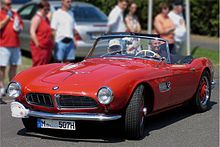- Albrecht von Goertz
-
Albrecht Graf von Schlitz genannt von Gortz von Wrisburg[1] (en: Count Albrecht von Goertz, known universally as Albrecht Goertz) (January 12, 1914 - October 27, 2006) was a German who designed cars for BMW including the BMW 503 and BMW 507.
Contents
Early life
He was born in Brunkensen in Lower Saxony, the second of three children Rudolf Graf von Schlitz gen. von Goertz und Freiherr von Wriesburg (1884–1933) and of Else Meyer (1882–1968). However, his elder brother Eberhard died, and while Albrecht did not technically inherit the honorific[citation needed], he began to call himself "The Count," and is often referred to that way.
After attending school, Goertz was apprenticed to Deutsche Bank in Hamburg and then in London at a private bank, Helbert Wagg & Co, but his prospects were not good, so in 1936 he emigrated to the United States of America. He eventually moved to Los Angeles and worked at a car wash and in a factory making aircraft engines. In 1938 Goertz rented a garage and showroom and modified Ford Model A and B models. On a Mercury chassis, he built a two-door coupe called the "Paragon". This was exhibited at the World Exhibition in New York in 1939.
Studebaker and BMW designs
Goertz joined the US Army in 1940 and served for five years. After leaving the Army he drove the Paragon to New York and while driving it he accidentally encountered Raymond Loewy, the famous car designer. Loewy invited Goertz to his office, sent him to college to learn about design and later gave him a job in the Studebaker studio in Indiana.
Goertz in 1953 set up his own design business and got to know Max Hoffman, BMW's main importer in America. Hoffman knew of BMW's plans to build a sports car and suggested that Goertz should contact BMW in Munich. Goertz then designed both the BMW 503 and the BMW 507, both of 1955.
Other car designs
Goertz claimed that he worked for Porsche, although this 'work' seems to have been an unsolicited 'design' submission for the 901, which was rejected. However he was employed as a consultant to Nissan - visiting the factory intermittently over a limited period, mainly to instruct in full-size clay modelling. He also carried out consultation work on a two seater sports car project for Nissan. The prototype was called the Datsun Coupe 1500 (later officially debut as the Nissan Silvia CSP311). Goertz then worked on another prototype, the Nissan 2000GT, in collaboration with Yamaha. When Nissan abandoned the project, Yamaha approached Toyota - using the Nissan 2000GT prototype as an example of their work. Toyota then worked with Yamaha on what became the Toyota 2000GT(note the design of the Toyota 2000GT was different from the Nissan version and it was made by Toyota designer Satoru Nozaki). His last design was a grand piano for Steinway & Sons to celebrate the 125th anniversary of their Hamburg factory.
Personal life
He married Julie Freiin von Bodenhausen (Baroness of Bodenhausen),(1902–1951) but they separated in 1942. He married Susanne Nettel (1925-) in 1957 and they had a son, Peter Joseph, who was born in 1959.
Notes
Regarding personal names: Graf is a title, translated as Count, not a first or middle name. The female form is Gräfin.
References
- ^ "Person Page 9504". thePeerage.com. http://thepeerage.com/p9504.htm#i95032. Retrieved 2010-12-03.
Categories:- 1914 births
- 2006 deaths
- German automobile designers
- German nobility
Wikimedia Foundation. 2010.

